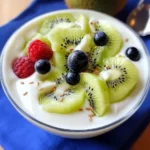It started, as many great things do, quite simply. One rushed morning, staring into the fridge, I needed something fast, healthy, and energizing. A tub of low-fat Greek yogurt sat beside a couple of perfectly ripe kiwis. On a whim, I combined them, expecting little more than sustenance. What I got was a revelation! The creamy, tangy yogurt paired exquisitely with the vibrant, sweet-tart kiwi, speckled with its tiny black seeds. It wasn’t just edible; it was delicious. Since that day, this Low-Fat Yogurt and Kiwi combination has become a staple in our household. My kids, initially skeptical of the “green fruit,” are now enthusiastic converts, often requesting it for breakfast or as an after-school snack. It’s their “special fancy yogurt.” For me, it’s the perfect guilt-free treat – satisfying, refreshing, and packed with goodness. Its simplicity is its genius; minimal effort yields maximum flavour and health benefits. Whether enjoyed as a quick breakfast, a light lunch component, a post-workout refuel, or even a simple dessert, this recipe consistently delivers. It’s proof that healthy eating doesn’t have to be complicated or bland; sometimes, the best combinations are the most straightforward, relying on the natural quality of the ingredients to shine. This humble bowl of yogurt and kiwi has brought a little burst of sunshine and wellness into our daily routine, and I’m genuinely excited to share this easy, delightful recipe with you.
Ingredients
- 1 cup Low-Fat Greek Yogurt (or Plain Low-Fat Yogurt): Serves as the creamy, protein-rich base. Choose plain yogurt to control sweetness and flavour. Greek yogurt offers a thicker texture and higher protein content.
- 2 Ripe Kiwis: Provide natural sweetness, a tangy counterpoint, vibrant colour, and a significant dose of Vitamin C. Ensure they yield slightly to gentle pressure.
- Optional: 1 teaspoon Honey, Maple Syrup, or Agave Nectar: For those who prefer a touch more sweetness. Adjust the amount according to your taste and the natural sweetness of the kiwi.
- Optional: 1 tablespoon Chopped Nuts or Seeds (e.g., almonds, walnuts, chia seeds, flax seeds): Adds textural contrast (crunch) and healthy fats, fiber, and minerals.
Instructions
- Prepare the Kiwis: Wash the kiwis thoroughly under cold running water. Place a kiwi on a cutting board. Using a small paring knife, slice off both ends of the kiwi. You can then either use the knife to carefully cut away the fuzzy brown skin, working from top to bottom, or use a spoon: slide a tablespoon between the skin and the flesh and rotate the kiwi (or the spoon) to scoop out the fruit cleanly.
- Slice or Dice the Kiwis: Once peeled, slice the kiwis into rounds (about 1/4-inch thick) or dice them into small cubes, depending on your preference for presentation and texture.
- Assemble the Bowl: Spoon the low-fat yogurt into a serving bowl or glass. Create a smooth base.
- Add the Kiwi: Arrange the sliced or diced kiwi pieces attractively over the top of the yogurt. You can layer them, create patterns, or simply pile them on.
- Add Optional Sweetener: If using, drizzle the honey, maple syrup, or agave nectar evenly over the kiwi and yogurt. Start with a small amount; you can always add more.
- Add Optional Toppings: If desired, sprinkle the chopped nuts or seeds over the top for added crunch and nutritional value.
- Serve Immediately: It’s best to enjoy this combination fresh, especially as the enzymes in kiwi can sometimes interact with dairy over time.
Nutrition Facts
- Serving Size: 1 serving
- Calories: Approximately 180-250 kcal per serving (This is an estimate and varies based on the specific yogurt used and optional additions like sweeteners and nuts/seeds).
- Protein: Rich in protein (especially if using Greek yogurt), crucial for muscle maintenance, satiety, and overall body function. Yogurt is an excellent source. (Approx. 15-20g depending on yogurt type).
- Vitamin C: Kiwis are exceptionally high in Vitamin C, a potent antioxidant that supports immune system health, skin vitality, and wound healing. Two kiwis can often meet or exceed the daily recommended intake.
- Calcium: Yogurt is a good source of calcium, essential for strong bones and teeth, as well as nerve function and muscle contraction.
- Fiber: Contains dietary fiber, primarily from the kiwi (and optional nuts/seeds), which aids digestion, promotes gut health, and contributes to feelings of fullness.
- Probiotics: If using yogurt with live and active cultures, this recipe provides beneficial probiotics that support a healthy gut microbiome, potentially improving digestion and immunity.
Preparation Time
- Total Time: Approximately 5-7 minutes.
- This recipe is incredibly quick and requires no cooking. The main effort involves washing, peeling, and slicing the kiwi fruit. Its speed makes it an ideal choice for busy mornings, quick snacks, or when you need a healthy option without much fuss.
How to Serve
This simple Low-Fat Yogurt and Kiwi combination is wonderfully versatile. Here are several ways to serve and enjoy it:
- Classic Breakfast Bowl:
- Serve in a standard cereal bowl.
- Top with kiwi slices arranged in a pattern.
- Consider adding a sprinkle of low-sugar granola or rolled oats for extra fiber and texture.
- Elegant Parfait:
- Use a clear glass or parfait glass.
- Layer the ingredients: start with a layer of yogurt, followed by a layer of diced kiwi, then repeat.
- Add thin layers of crushed nuts or seeds between the yogurt and kiwi for added crunch and visual appeal.
- Garnish the top layer with a perfectly placed kiwi slice or a mint sprig.
- Quick Grab-and-Go Snack:
- Prepare in a small reusable container with a lid.
- Keep the kiwi separate (perhaps in a small zip-top bag or section of the container) if preparing more than an hour ahead, to prevent the yogurt from becoming watery or bitter. Combine just before eating.
- Light & Healthy Dessert:
- Serve in a small, attractive dessert dish or coupe glass.
- Drizzle generously with honey or maple syrup.
- Consider adding a tiny grating of dark chocolate or a sprinkle of cinnamon for a more dessert-like feel.
- As a Topping:
- Use the yogurt and kiwi mixture as a healthy and refreshing topping for whole-wheat pancakes, waffles, or French toast instead of syrup.
- Part of a Larger Spread:
- Serve smaller portions in individual cups as part of a brunch buffet or healthy breakfast spread alongside other fruits, breads, and proteins.
- Frozen Treat Base:
- Blend the yogurt and kiwi (perhaps with a touch more sweetener or a banana) and freeze in popsicle molds for a healthy frozen treat.
- Alternatively, spoon small dollops onto a parchment-lined baking sheet and freeze for mini frozen yogurt bites.
Additional Tips
- Choose Your Yogurt Wisely: While the recipe calls for low-fat, feel free to experiment. Greek yogurt provides more protein and a thicker, tangier base. Regular plain yogurt is smoother and milder. Always opt for plain yogurt to control the sugar content – fruit yogurts are often loaded with added sugars. Check the label for “live and active cultures” to ensure probiotic benefits. Non-fat options are also available if you’re strictly watching fat intake, though low-fat often provides better flavour and satiety.
- Perfect Kiwi Selection is Key: Ripe kiwis are essential for the best flavour. A ripe kiwi should yield slightly to gentle pressure, similar to a ripe peach or avocado. Avoid kiwis that are rock hard (they will be sour and astringent) or overly soft and mushy (they are past their prime). If you can only find hard kiwis, leave them at room temperature for a few days (away from direct sunlight) to ripen. Placing them in a paper bag, possibly with a banana or apple, can speed up the process.
- Sweeten Thoughtfully: Taste the yogurt and kiwi combination before adding any sweetener. Ripe kiwis can be quite sweet on their own. If you do add sweetener, start small (1/2 teaspoon) and adjust upwards. Honey, maple syrup, and agave nectar are popular liquid options. You could also try a sprinkle of date sugar or a few drops of liquid stevia for a lower-calorie alternative. Or, embrace the natural tang and omit added sweeteners entirely!
- Boost Texture and Nutrition: Don’t underestimate the power of toppings! Beyond nuts and seeds (think almonds, walnuts, pecans, pistachios, chia seeds, flax seeds, pumpkin seeds, sunflower seeds), consider adding shredded unsweetened coconut, cacao nibs for a bitter chocolate crunch, bee pollen, or a high-fiber, low-sugar granola or muesli. These additions provide texture, healthy fats, fiber, and micronutrients.
- Introduce Flavor Variations: Elevate the simple base by mixing flavourings into the yogurt before adding the kiwi. A splash of vanilla extract, a pinch of cinnamon or cardamom, or a tiny bit of almond extract can add warmth and complexity. A grating of fresh lemon or lime zest folded into the yogurt can enhance the brightness and complement the kiwi’s tanginess beautifully.
- Meal Prep Strategy: While best assembled fresh, you can prep components ahead for ultra-fast assembly. Wash and peel the kiwi, storing it sliced or diced in an airtight container in the fridge for up to 2 days. Portion the yogurt into individual containers. When ready to eat, simply combine the prepped kiwi and yogurt, adding any desired toppings. Avoid mixing them too far in advance as the kiwi’s enzymes can alter the yogurt’s texture and taste.
- Temperature Matters: Most people prefer this combination chilled, straight from the refrigerator. However, allowing the yogurt to sit at room temperature for 5-10 minutes before serving can slightly mellow the tanginess and enhance the perception of sweetness for some palates. For a completely different experience on a hot day, try partially freezing the diced kiwi before adding it to the cold yogurt for an icy crunch.
- Presentation Enhances Enjoyment: We eat with our eyes first! Take an extra minute to arrange the kiwi slices nicely on top. Using a clear glass for a parfait highlights the layers. A sprinkle of bright green chopped pistachios or a tiny mint leaf can add a pop of colour and make this simple dish feel special. Even just swirling the yogurt slightly before topping can make it look more appealing.
FAQ
- Q: Is Low-Fat Yogurt and Kiwi a truly healthy choice?
- A: Absolutely. This combination offers a fantastic balance of macronutrients and micronutrients. You get high-quality protein and calcium from the low-fat yogurt (plus probiotics if using cultured yogurt), which aids satiety and bone health. The kiwi provides exceptional levels of Vitamin C for immune support, along with Vitamin K, potassium, and dietary fiber for digestive health. It’s naturally low in fat and, if you use plain yogurt and minimal sweetener, low in added sugars. It’s a nutrient-dense option perfect for breakfast, snacks, or a light dessert.
- Q: Can I use full-fat yogurt instead of low-fat?
- A: Yes, you certainly can. Full-fat yogurt will provide a richer flavour and creamier texture, which many people prefer. Nutritionally, it will be higher in calories and saturated fat. Whether this is suitable depends on your individual dietary needs and preferences. If you’re not strictly monitoring fat intake, full-fat plain yogurt (especially Greek yogurt) can be a delicious and satisfying alternative.
- Q: What happens if I use frozen kiwi? Can I use it?
- A: You can use frozen kiwi, but be aware of the texture change. When thawed, frozen kiwi becomes much softer and can release more liquid than fresh kiwi. It might not be ideal for arranging neat slices on top. However, partially thawed frozen kiwi chunks can add a pleasant, slushy coolness to the yogurt. Frozen kiwi works very well if you plan to blend the yogurt and kiwi into a smoothie. If using thawed kiwi, you might want to drain off excess liquid before adding it to the yogurt.
- Q: How long will this last in the refrigerator after I make it?
- A: It’s strongly recommended to eat the Low-Fat Yogurt and Kiwi combination immediately after preparation for the best taste and texture. Kiwi contains an enzyme called actinidin, which breaks down milk proteins. If left mixed together for too long (even a few hours in the fridge), the yogurt can start to develop a slightly watery texture and potentially a bitter taste. If you need to prepare ahead, store the yogurt and sliced/diced kiwi in separate airtight containers in the refrigerator and combine them just before serving. Stored separately, the yogurt should last until its expiration date, and the cut kiwi for 1-2 days.
- Q: Is this recipe good for weight loss or weight management?
- A: Yes, this recipe can be very beneficial for weight management when incorporated into a balanced diet. It’s relatively low in calories but high in protein and fiber, two nutrients known to promote feelings of fullness and satiety, which can help control overall calorie intake. Using low-fat or non-fat plain yogurt and limiting added sweeteners keeps the calorie and sugar count down. The natural sweetness of the kiwi satisfies cravings healthily. However, portion control is still important, as are any high-calorie additions like large amounts of nuts or granola.
- Q: How can I make this recipe dairy-free or vegan?
- A: It’s very easy to adapt this recipe for dairy-free or vegan diets. Simply replace the low-fat dairy yogurt with a plant-based alternative. Excellent options include unsweetened almond yogurt, soy yogurt, coconut yogurt (which adds a distinct flavour), or oat yogurt. Look for plain, unsweetened varieties to control the sugar content and ensure they are fortified with calcium and Vitamin D if those are concerns. The rest of the recipe (kiwi, optional sweeteners like maple syrup, nuts/seeds) remains the same.
- Q: Besides Vitamin C, what are the main health benefits of eating kiwi?
- A: While famous for Vitamin C, kiwis offer much more! They are a good source of dietary fiber, aiding digestion and preventing constipation. They contain Vitamin K, important for blood clotting and bone health, as well as Vitamin E (an antioxidant) and potassium (helps regulate blood pressure). Kiwis also contain antioxidants like lutein and zeaxanthin, beneficial for eye health. Furthermore, the enzyme actinidin found in kiwi can help break down proteins, potentially aiding digestion, particularly after a protein-rich meal (though this is the same enzyme that affects dairy if left too long).
- Q: Sometimes my kiwi makes the yogurt taste slightly bitter or gives me a tingly feeling in my mouth. Why does this happen?
- A: This is likely due to the enzyme actinidin present in kiwis. Actinidin is a protease, meaning it breaks down proteins – including the proteins in dairy (like yogurt) and sensitive proteins in your mouth. When mixed with yogurt and left to sit, this enzymatic action can sometimes create compounds that taste bitter. The tingling sensation some people experience is also attributed to actinidin interacting with the delicate tissues in the mouth; it’s usually harmless but can be more pronounced for some individuals or with very ripe kiwis. Eating the combination immediately after mixing usually minimizes these effects. Using slightly less ripe kiwi might also help reduce the enzyme’s activity.

Low-Fat Yogurt and Kiwi
Ingredients
- 1 cup Low-Fat Greek Yogurt (or Plain Low-Fat Yogurt): Serves as the creamy, protein-rich base. Choose plain yogurt to control sweetness and flavour. Greek yogurt offers a thicker texture and higher protein content.
- 2 Ripe Kiwis: Provide natural sweetness, a tangy counterpoint, vibrant colour, and a significant dose of Vitamin C. Ensure they yield slightly to gentle pressure.
- Optional: 1 teaspoon Honey, Maple Syrup, or Agave Nectar: For those who prefer a touch more sweetness. Adjust the amount according to your taste and the natural sweetness of the kiwi.
- Optional: 1 tablespoon Chopped Nuts or Seeds (e.g., almonds, walnuts, chia seeds, flax seeds): Adds textural contrast (crunch) and healthy fats, fiber, and minerals.
Instructions
- Prepare the Kiwis: Wash the kiwis thoroughly under cold running water. Place a kiwi on a cutting board. Using a small paring knife, slice off both ends of the kiwi. You can then either use the knife to carefully cut away the fuzzy brown skin, working from top to bottom, or use a spoon: slide a tablespoon between the skin and the flesh and rotate the kiwi (or the spoon) to scoop out the fruit cleanly.
- Slice or Dice the Kiwis: Once peeled, slice the kiwis into rounds (about 1/4-inch thick) or dice them into small cubes, depending on your preference for presentation and texture.
- Assemble the Bowl: Spoon the low-fat yogurt into a serving bowl or glass. Create a smooth base.
- Add the Kiwi: Arrange the sliced or diced kiwi pieces attractively over the top of the yogurt. You can layer them, create patterns, or simply pile them on.
- Add Optional Sweetener: If using, drizzle the honey, maple syrup, or agave nectar evenly over the kiwi and yogurt. Start with a small amount; you can always add more.
- Add Optional Toppings: If desired, sprinkle the chopped nuts or seeds over the top for added crunch and nutritional value.
- Serve Immediately: It’s best to enjoy this combination fresh, especially as the enzymes in kiwi can sometimes interact with dairy over time.
Nutrition
- Serving Size: one normal portion
- Calories: 250
- Protein: 20g






